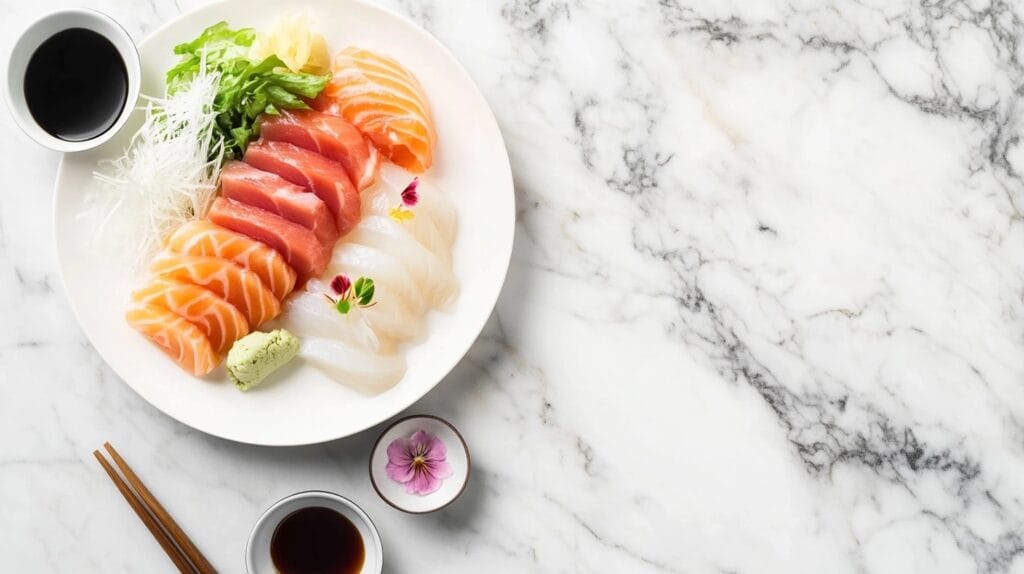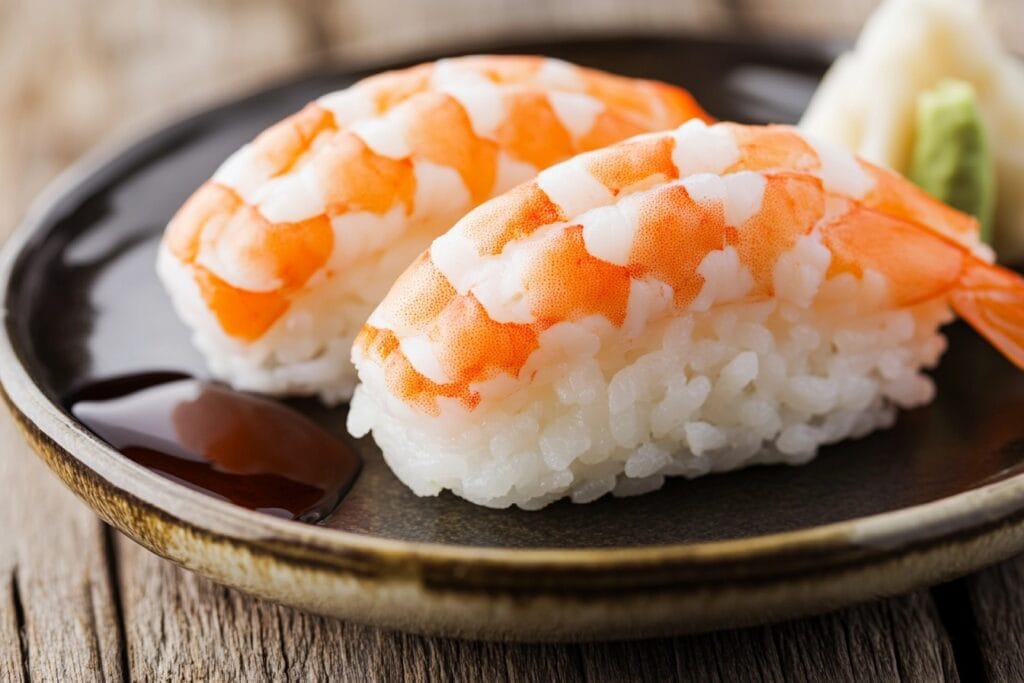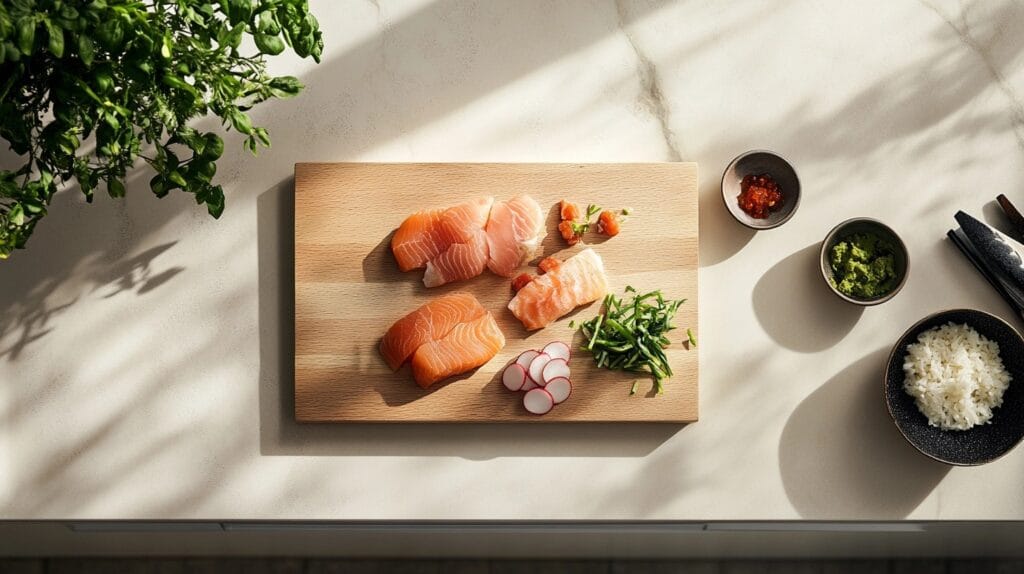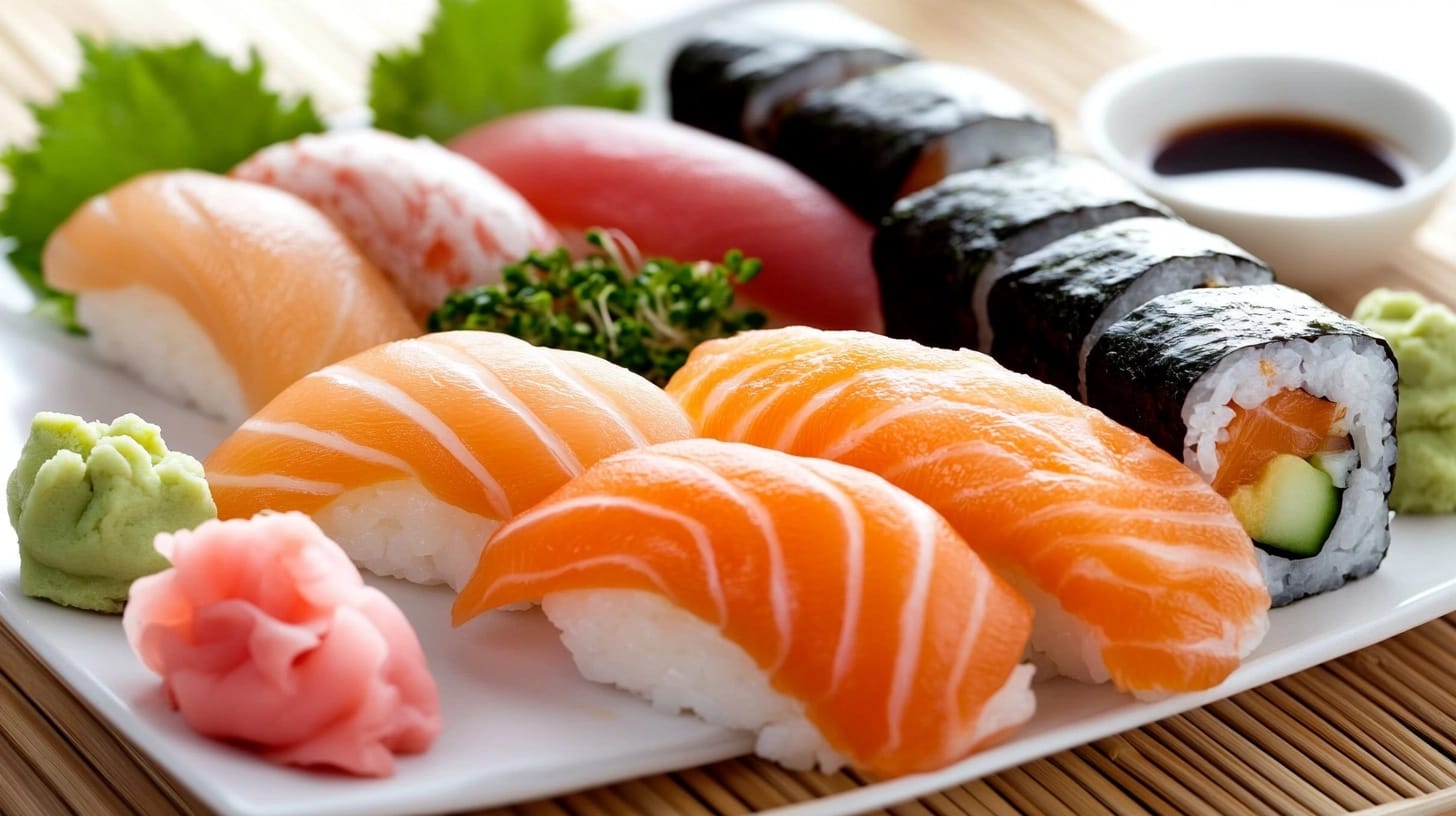1. Introduction
Sushi has taken the world by storm, offering a culinary experience that is as artistic as it is flavorful. Among its many components, two stand out for their simplicity and elegance: sashimi and nigiri. These staples of Japanese cuisine showcase the artistry of raw fish, yet their differences often leave people puzzled. What is the difference between sashimi and nigiri?
To answer that question, it’s essential to understand how these dishes are prepared, served, and enjoyed. While both celebrate the beauty of fresh ingredients, they cater to distinct preferences and occasions. This article will guide you through everything you need to know about sashimi and nigiri, from their origins and preparation techniques to tips for enjoying them at their best. Whether you’re a sushi lover or a curious foodie, you’ll find this exploration both insightful and deliciously tempting.
Related: For more insights into sushi basics, visit Sashimi vs. Nigiri: Differences and Tips.
Print
What is the Difference Between Sashimi and Nigiri? Sushi Essentials Explained
- Total Time: 15 minutes
- Yield: 2 servings
Description
Curious about the difference between sashimi and nigiri? This guide breaks down everything from origins and preparation to flavor and presentation. Discover how these two iconic dishes represent the heart of Japanese cuisine.
Ingredients
- Sashimi: Thinly sliced raw fish or meat (e.g., tuna, salmon, yellowtail)
- Nigiri: Hand-pressed vinegared rice with fish or seafood on top
- Soy sauce (for dipping)
- Wasabi (used sparingly)
- Optional garnishes: shredded daikon, shiso leaves, edible flowers
- Optional toppings: cooked eel, shrimp, tamago (sweet omelet)
Instructions
- Sashimi Preparation: Use a sharp knife to slice raw fish into thin, even pieces. Arrange with garnishes like shredded daikon and shiso leaves. Serve with soy sauce and wasabi.
- Nigiri Preparation: Prepare vinegared rice and shape into small mounds. Place slices of fish on top. Optionally secure with a thin strip of nori. Dip fish-side into soy sauce when eating.
- Enjoy: Pair both with traditional sides like miso soup or seaweed salad and drinks like green tea or sake for an authentic experience.
Notes
Sashimi focuses on the pure flavor of raw fish, while nigiri balances fish and rice. Sashimi is typically lighter and served first in multi-course meals. Nigiri may include cooked toppings and is more filling.
- Prep Time: 15 minutes
- Cook Time: 0 minutes
- Category: Appetizer
- Method: Raw Preparation
- Cuisine: Japanese
Nutrition
- Serving Size: 1 plate
- Calories: 200
- Sugar: 0g
- Sodium: 300mg
- Fat: 6g
- Saturated Fat: 1g
- Unsaturated Fat: 4g
- Trans Fat: 0g
- Carbohydrates: 15g
- Fiber: 0g
- Protein: 20g
- Cholesterol: 35mg
Keywords: sashimi, nigiri, sushi, Japanese cuisine, sushi types
2. Origins of Sushi and How Nigiri and Sashimi Developed
Sushi’s history dates back centuries, rooted in a practical method for preserving fish. In ancient Japan, fish was salted and wrapped in fermented rice to maintain its freshness. This process, known as narezushi, laid the foundation for modern sushi. Over time, the emphasis shifted from preservation to taste, giving rise to various styles, including sashimi and nigiri.
By the Edo period, sushi evolved into a convenient street food, with fresh fish and vinegared rice becoming its key ingredients. It was during this era that nigiri emerged as a quick yet elegant option, while sashimi maintained its role as a refined dish highlighting the quality of raw fish. Today, these dishes are celebrated worldwide, each offering a unique way to enjoy the ocean’s bounty.

3. Understanding Sashimi: A Raw Fish Dish Without Rice
Sashimi is a dish that epitomizes simplicity and precision. At its core, sashimi is thinly sliced raw fish or meat, served without rice. This dish is all about showcasing the pure, unadulterated flavor of its main ingredient, making the quality of the fish paramount.
Sashimi Explained: Key Features of This Japanese Staple
The hallmark of sashimi lies in its purity. Unlike sushi, which incorporates vinegared rice, sashimi focuses entirely on the protein, allowing the natural flavors of the fish or meat to take center stage. Moreover, its name, which translates to “pierced body,” underscores the simplicity and deep reverence for the ingredient itself. Additionally, each slice is carefully and precisely cut to achieve not only the ideal texture but also a visually stunning presentation, further showcasing the skill and artistry behind this iconic Japanese dish.
Popular Sashimi Types: What Sets Tuna, Salmon, and More Apart
Sashimi is often prepared with the freshest fish and seafood available. Some popular options include:
- Tuna (Maguro): Known for its versatility, offering both lean and fatty cuts.
- Salmon (Sake): A rich, buttery choice favored worldwide.
- Yellowtail (Hamachi): Slightly sweet and oily, a crowd favorite.
- Octopus (Tako): Often lightly cooked for an enjoyable chewiness.
- Scallops (Hotate): Sweet, delicate, and perfect for sashimi.
How is Sashimi Served?
Sashimi is elegantly presented with garnishes such as shredded daikon radish, fresh shiso leaves, or even edible flowers, adding a visual and aromatic appeal to the dish. It is typically served alongside soy sauce for dipping, with wasabi used sparingly to provide a subtle hint of heat without overwhelming the delicate flavors. Additionally, complementary sauces like ponzu or dashi soy can further enhance its flavor profile. In Japanese dining, sashimi is often enjoyed as the first course of a multi-course meal, setting the tone with its refined simplicity and focus on the purity of the ingredients.

4. Understanding Nigiri: Sushi with Rice and Fish
Nigiri, on the other hand, takes a more filling approach to sushi. This dish combines a small, hand-pressed mound of vinegared rice with a topping of raw fish or seafood. The word “nigiri,” which means “two fingers,” refers to its size and shape, perfect for a single bite.
What is Nigiri? A Sushi Type Explained
Nigiri stands out for its perfect balance of flavors. The slightly tangy vinegared rice pairs beautifully with the topping, creating a harmonious and satisfying combination in every bite. Unlike sashimi, which focuses solely on raw fish, nigiri often includes cooked ingredients such as grilled eel (unagi) or boiled shrimp (ebi), alongside the more traditional raw fish options. This versatility makes nigiri a popular choice for those seeking a variety of textures and flavors.
Common Nigiri Toppings: From Salmon to Cooked Eel
Nigiri offers a variety of topping options, catering to different palates. Popular choices include:
- Salmon (Sake): Creamy and flavorful, a classic choice.
- Tuna (Maguro): Ranges from lean to fatty, offering diverse textures.
- Eel (Unagi/Anago): Grilled and glazed with a sweet soy sauce.
- Shrimp (Ebi): Cooked or grilled, providing a tender bite.
- Squid (Ika): Smooth and slightly chewy, often scored for tenderness.
Preparation and Eating Etiquette
Crafting nigiri requires both skill and precision. Sushi chefs meticulously shape the rice, ensuring that it maintains its form while remaining light and not overly compact. Next, the fish is delicately placed atop the rice, sometimes secured with a thin strip of nori for added stability. Additionally, when eating nigiri, it’s important to dip the fish side—not the rice—into soy sauce. This method not only enhances the flavor but also prevents the rice from falling apart, ensuring a perfect bite every time.
5. Key Differences Between Sashimi and Nigiri: A Side-by-Side Comparison
When comparing sashimi and nigiri, the differences become clear. While both celebrate the freshness of raw fish, their presentation, preparation, and overall experience are distinct.
| Aspect | Sashimi | Nigiri |
|---|---|---|
| Rice | No rice | Includes vinegared rice |
| Presentation | Thinly sliced fish with garnishes | Fish placed atop a rice mound |
| Focus | Pure flavor of the fish | Balance of fish and rice |
| Eating Etiquette | With chopsticks | With fingers or chopsticks |
| Versatility | Typically raw fish | Can include cooked ingredients |
Understanding these differences can greatly assist you in deciding which dish best suits your preferences or the occasion. For example, if you’re seeking a light and protein-rich option, sashimi might be the perfect choice. On the other hand, if you’re craving a more filling dish, nigiri provides a satisfying and balanced combination of flavors, blending vinegared rice with fresh toppings.
6. Exploring Common Misconceptions About Nigiri and Sashimi
Sashimi and nigiri often confuse people, even though they are both incredibly popular. For instance, many assume that sashimi qualifies as sushi; however, this is not entirely accurate. Sushi specifically refers to dishes made with vinegared rice, which sashimi does not include, as it focuses solely on raw fish or meat.
Furthermore, another common myth is that nigiri always features raw fish. On the contrary, chefs frequently use cooked toppings for nigiri, such as unagi (grilled eel) or tamago (sweet omelet). By clearly understanding these important distinctions, you can not only enhance your knowledge of Japanese cuisine but also gain a deeper appreciation for the artistry and techniques involved in crafting these iconic dishes.
7. Traditional Japanese Cuisine Insights
Sashimi and nigiri represent far more than just food—they truly embody the essence of Japanese culture. Not only do these dishes highlight a profound respect for nature’s bounty, but they also place a strong emphasis on seasonality and the unmatched freshness of ingredients.
In addition, sashimi and nigiri are often enjoyed during special occasions or as part of elegant formal meals in Japan. Furthermore, they symbolize refinement, precision, and an unwavering attention to detail, which ultimately makes them a cornerstone of the country’s rich culinary identity.
8. Tips for Trying Nigiri and Sashimi for the First Time
If you’re new to sushi, navigating the menu can feel overwhelming. Here are some tips to make your experience enjoyable:
- Start Simple: Begin with mild-flavored fish like salmon or tuna before venturing into bolder options like mackerel.
- Watch the Soy Sauce: Use soy sauce sparingly to avoid overpowering the delicate flavors.
- Pair Smartly: Complement your meal with green tea or sake for an authentic experience.
9. The Art of Sushi-Making: Chef’s Perspective
Sushi chefs spend years mastering their craft, refining skills that extend far beyond basic knife techniques. When preparing sashimi, they must carefully understand how to slice each type of fish to ensure the ideal texture and presentation. Likewise, crafting perfect nigiri involves striking a precise balance between the density of the rice, the placement of the fish, and the harmony of flavors in every bite.
10. Popular Sushi Pairings
To elevate your dining experience, pair sashimi and nigiri with complementary sides and drinks. Popular options include:
- Drinks: Sake, green tea, or a light beer.
- Sides: Miso soup, pickled ginger, and seaweed salad.

11. Home Preparation: Sashimi and Nigiri
Making sashimi and nigiri at home can be an incredibly rewarding experience. To get started, first ensure that you source the freshest fish from a trusted supplier. This step is crucial, as the quality of your ingredients directly impacts the flavor and safety of your dishes.
Steps for Sashimi:
- Use a sharp knife to slice fish into thin, even pieces.
- Arrange slices on a plate with garnishes like shredded daikon and shiso leaves.
Steps for Nigiri:
- Shape small mounds of vinegared rice.
- Place fish slices atop the rice, securing with nori if necessary.
- Serve with soy sauce and wasabi on the side.
12. Conclusion
Sashimi and nigiri beautifully showcase the artistry of Japanese cuisine, as each provides a unique and distinct way to savor the freshest fish. Moreover, by understanding their differences and fully savoring their distinct flavors, you can gain a deeper appreciation for the rich cultural and culinary heritage they represent. Therefore, if you are ready to expand your sushi knowledge and discover more about these iconic dishes, there has never been a better time to explore them.? Explore more on Sista Recipes.
13. FAQs
1. What is the biggest difference between nigiri and sashimi?
The biggest difference lies in the presence of rice. Nigiri includes a small mound of vinegared rice topped with fish, while sashimi is solely thin slices of raw fish or meat served without rice. This distinction makes nigiri a more filling option compared to sashimi.
2. Why is nigiri cheaper than sashimi?
Nigiri is often cheaper than sashimi because it uses smaller portions of fish combined with rice, whereas sashimi relies on larger, high-quality cuts of fish served on their own. The emphasis on the protein in sashimi contributes to its higher cost.
3. How is salmon served in nigiri sushi but not in sashimi?
In nigiri, salmon is paired with a hand-pressed mound of vinegared rice, creating a harmonious balance of flavors. For sashimi, salmon is served on its own, typically sliced more generously and paired with garnishes like shredded daikon radish or shiso leaves.
4. Is sashimi or nigiri healthier?
Sashimi is generally considered healthier because it is purely protein, without the added carbohydrates from rice. However, nigiri provides a balanced option with its combination of protein and energy-rich rice, making it a satisfying choice for many.

